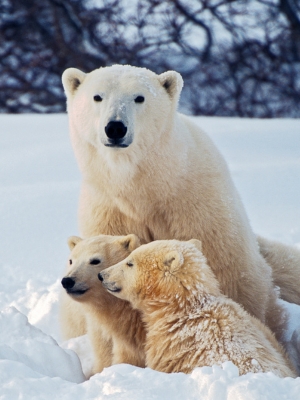The wind came roaring through the scrub and mesquite last night, picking up loose soil and sandblasting everything in its path. The temperature dropped suddenly and what was a pleasant fifty-degree night quickly turned into a dark, shivering ordeal as monkeys scrambled for their shelters. [teaserbreak]
This is typical of south Texas weather in February: comfortable one moment and bone-chilling the next. While we don’t normally experience the extreme cold and snow known to our northern neighbors, we do get our share of 20-degree nights and more than enough “yo-yo” days: 70 degrees at noon and 28 at midnight. It’s the wind chill and those severe temperature differentials that always concern us most, but the monkeys seem to figure out how to handle it.
We expect the snow monkeys to instinctually know what to do, but what about the rhesus macaques who evolved in regions of the world where they rarely, if ever, experienced this kind of winter weather? It turns out they manage very well, taking advantage of wind breaks, heated shelters, and group hugging to get them through the winter nights – but that’s after they’ve had some experience and practice.

Those monkeys newly retired from research always cause us the most concern, as they previously lived their entire lives in climate-controlled rooms, and now, outside, don’t always seem to make the association between the glow of a heated shelter and the warmth it offers. It’s not uncommon to see them sitting in the highest spot they can get to, huddled against the cold and shivering as the wind blows their fur around, exposing small areas of bare skin.
These are the images that wake me in the middle of the night, worried that, despite the availability of shelter, they won’t know enough to take advantage of it. There have been times when I’ve convinced myself that they must be miserable or in trouble, and after dressing and bundling up against the cold, made my way to their enclosure only to find no one in sight. Worried, I make some noise and sigh in relief as a startled face peers out from the shelter, concerned that something is going on that he or she can’t see.
Of course, they now have to investigate, so out of the house they go, climbing to the highest point possible to survey the area, and I realize I’ve done them a disservice by disturbing them. Still, it’s good to know that they will use the shelters, even though it’s clearly as a last resort.
Having spent their entire lives in cages, the sudden sense of freedom they experience must feel overwhelming, strange, and frightening—and yet, on a deeply instinctual level, so very right.
We use confinement as a means of punishing humans, and I believe that it’s just as unnatural and painful to other primates (who have broken no law)—so it’s no wonder they prefer open views to enclosed shelters, and early mornings watching the sun rise to the comfort of a warm box.
For the primates,
Tim
 Dear Reader,
Dear Reader,